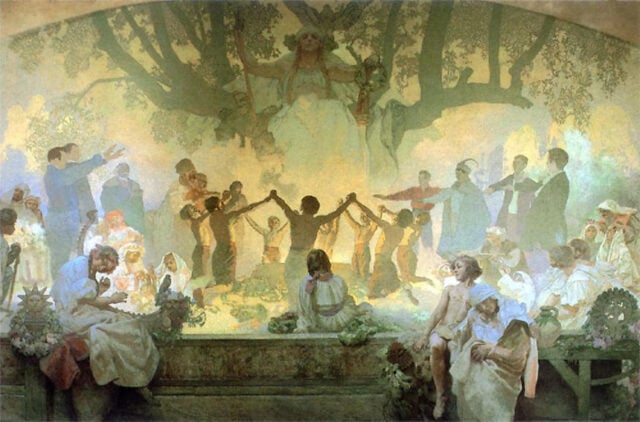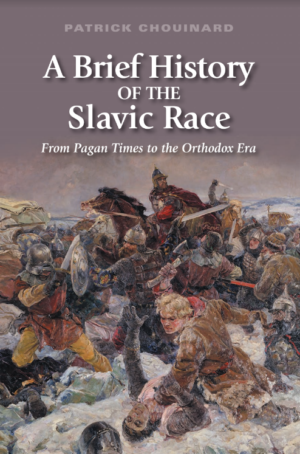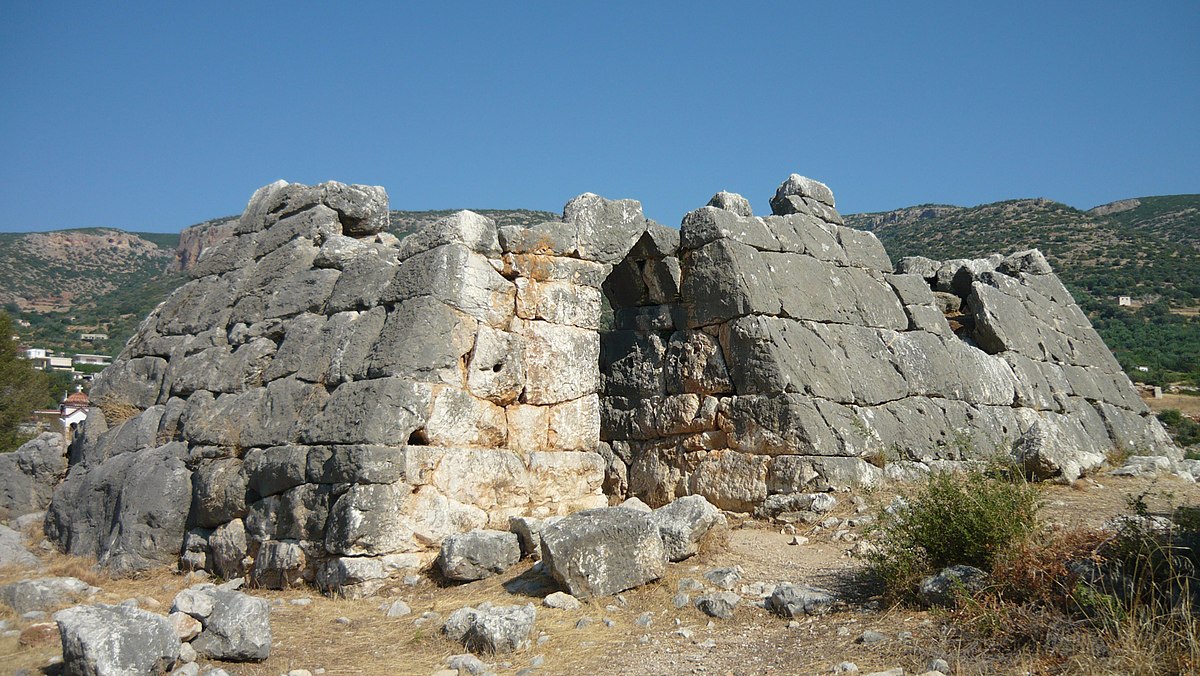Note: Partick’s new book A Brief History of the Slavic Race: From Pagan Times to the Orthodox Era is available for purchase on Alt Archaeology.
The Slavic peoples are a prominent ethno-linguistic group in Europe, renowned for their substantial contributions to the cultural and historical fabric of the continent. Their origins and early cultural advancements are extensively studied and discussed by historians and archaeologists. The exact origins of the Slavs remain relatively unknown, with a significant portion of the knowledge obtained from archaeological discoveries, linguistic research, and early historical documents. The Slavs belong to the broader Indo-European family, comprising several ethno-linguistic groups that have a shared ancestor language.
Proto-Indo-European Roots
The Proto-Slavic language, which later developed into the contemporary Slavic languages, emerged from the wider Proto-Indo-European linguistic group. It appears that the divergence of this proto-language began around 1500 BCE. The prevailing explanation regarding the origin of the early Slavs suggests that they inhabited the Pripet Marshes, which includes areas of present-day Belarus, Poland, and Ukraine. This marshy and wooded area is believed to have been the birthplace of Slavic civilization during the late Bronze Age and early Iron Age (about 1500 BCE to 500 CE). Archaeological evidence, including findings from the Prague-Korchak, Penkovka, and Kolochin civilizations, offers valuable insights into the early Slavic way of life. The cultures that thrived between the 6th and 7th centuries CE provide clear indications of Slavic settlement patterns, burial customs, and material culture.
Initial Migrations and Growth
The Slavic peoples had substantial migrations and expansions during the early medieval period. The moves were motivated by a confluence of factors, including population density, shifts in climate, and interactions with other communities. The Great Migration Period, which occurred from the 4th to 6th centuries CE, witnessed a significant and widespread migration of Slavs. During the Migration Period, many groups, such as the Huns, Goths, and Avars, migrated throughout Europe. The Slavs expanded in various directions: west into Central Europe, south into the Balkans, and north into the Eastern European lowlands.
Encounters with the Byzantine Empire
As the Slavs migrated towards the south, they established touch with the Byzantine Empire. These encounters frequently involved both conflict and collaboration. By the 6th century, the Byzantines referred to the Slavs as “Sclavenes” and documented their existence in the Balkans. The initial encounters had a significant impact on Slavic military strategies, patterns of settlement, and cultural customs. The emergence of early Slavic states During the late 7th century, a number of early Slavic political entities started to appear. Samo’s Empire, a brief alliance of Slavic tribes in Central Europe, and the establishment of the early Bulgarian state, which resulted from the merging of Slavic and Turkic Bulgar components, are two significant examples. #### Cultural and Social Structures The early Slavs cultivated unique cultural and social systems that were distinguished by their farming methods, spiritual convictions, and societal arrangement.
Agricultural Practices
The early Slavs primarily engaged in agrarian activities, relying heavily on subsistence farming. The ancient civilization engaged in the cultivation of several crops, including barley, wheat, millet, and rye, alongside the practice of animal husbandry. Agricultural productivity was greatly enhanced by the implementation of the heavy plow and crop rotation techniques.
Religious Beliefs and Practices
The religion practiced by the Slavic people before the arrival of Christianity was polytheistic, meaning they believed in multiple gods. These gods were associated with natural forces and different parts of everyday life. Notable deities in Slavic mythology were Perun (the deity associated with thunder and lightning), Veles (the deity associated with the underworld and livestock), and Mokosh (the deity associated with fertility and the ground). Religious practices frequently encompassed ceremonies, offerings, and celebrations associated with the agricultural cycle. Chieftains served as the leaders of these tribal groupings in early Slavic cultures. These tribes frequently belonged to bigger confederations, particularly when facing external threats or seeking to expand. The social structure had a notable degree of egalitarianism, characterized by prevalent community decision-making and widespread land ownership. The Slavs had a significant role in Medieval Europe. The Slavs, upon their settlement in different parts of Europe, exerted significant influence on the political, cultural, and economic advancements during the medieval era.
Assimilation of Slavic Groups into Preexisting Political Structures

Slavic communities in various places merged with or established fresh political institutions. In the Balkans, the amalgamation of Slavic tribes with the remaining Roman populace and other migratory factions gave rise to early medieval nations, namely Croatia and Serbia. The East Slavic tribes in Eastern Europe established the groundwork for the Kievan Rus’, which would later emerge as a significant governmental and cultural entity.
Cultural Exchange and Syncretism
The exchanges between the Slavs and their neighbors resulted in substantial cultural exchange. The introduction of Christianity in the 9th century was a pivotal moment. The missionary endeavors of Saints Cyril and Methodius, who devised the Glagolitic script (a forerunner to Cyrillic), promoted the dissemination of Christianity and literacy among the Slavic people. During this era, there was a merging of Slavic pagan customs with Christian rituals.
Further Development of Slavic Society
The Slavs made significant economic contributions to medieval Europe through their involvement in agriculture, trade, and craftsmanship. Slavic craftsmen were renowned for their expertise in ceramics, metalworking, and textile production. The Slavs developed trade networks that interconnected different regions of Europe, enabling the flow of commodities and cultural concepts.
Over the course of history, the Slavic population gradually fragmented into three primary divisions: the West Slavs, the East Slavs, and the South Slavs. Every branch evolved unique linguistic, cultural, and political characteristics. The West Slavs encompass the Polish, Czech, and Slovak ethnic groups. Germanic and Latin neighbors greatly influenced the West Slavs, leading to their assimilation of the Latin alphabet and Western Christian customs. The emergence of Polish and Bohemian states in the 10th century signaled the ascent of prominent political entities within the West Slavic region. Encounters with the Byzantine Empire and the Turkic nomads of the steppes shaped the East Slavs, including the Russians, Ukrainians, and Belarusians. The Kievan Rus’ exerted significant influence on the political and cultural advancement of the East Slavs. The incorporation of Eastern Orthodox Christianity and the utilization of the Cyrillic script were crucial characteristics that shaped the East Slavic cultural identity. The migration of the South Slavs, including the Serbs, Croats, Bulgarians, and Slovenes, to the Balkans exposed them to the cultural influences of both the Byzantine and Western European civilizations. The South Slavs exhibited notable cultural and political heterogeneity, as several factions embraced Eastern Orthodoxy while others adhered to Roman Catholicism. Throughout the medieval era, the emergence of the Bulgarian and Serbian empires showcased the political achievements of the South Slavs.
Conclusion
The roots and early cultures of Europe’s Slavic peoples are intricate and diverse, showcasing a wealth of migrations, interactions, and cultural advancements. The Slavs were instrumental in molding Europe’s history, starting from their origins in the Pripet Marshes and expanding across the continent. Their agricultural methods, social organizations, and religious convictions laid the groundwork for dynamic and varied cultures that would continue to develop and impact the wider European environment during the medieval era and beyond. Examining the Slavic peoples offers significant perspectives on the mechanisms of cultural and political transformation during the early stages of European history.

Patrick Chouinard is a distinguished expert on European history and authority on the White race and its roots. He has a BA in Global History and European Studies and currently is seeking an MA in Ancient and Classical History. He has authored six books and is a regular contributor to notable publications such as Ancient American magazine, The Barnes Review, Renegade Tribune, and Nexus. His expertise spans various facets of European history, showcasing a deep understanding and commitment to disseminating historical knowledge.













